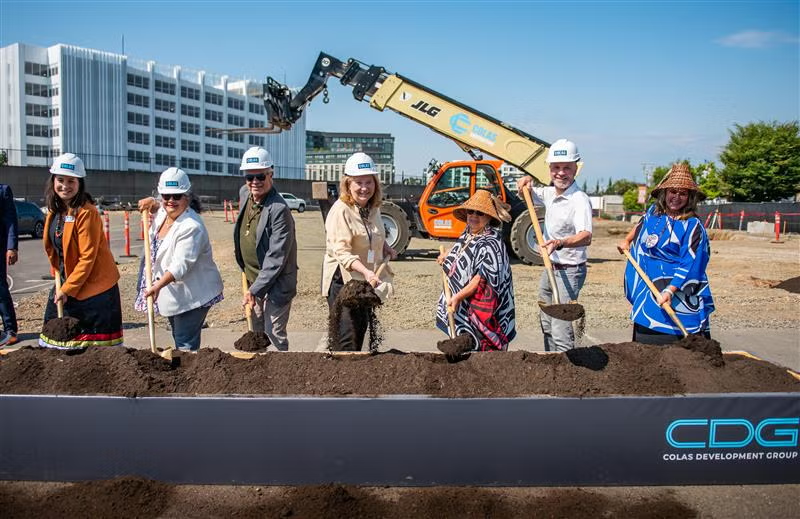Mamook Tokatee grand opening highlights reverence for Indigenous culture keepers

Our hearts are bursting with love and gratitude following the Mamook Tokatee ribbon cutting and open house on May 5. NAYA’s supporters showed up in droves for the special event, celebrating this new opportunity in affordable housing for the region’s Native population. A prominent theme throughout the program was recognition that artists have always been revered culture keepers in Native communities, and those words rang true with our newest housing development as the backdrop for the event. “The building has an artist preference, and it also has a Native American preference, which is very unusual, but it’s very beautiful, too,” NAYA CEO Paul Lumley told the crowd. “The art theme was so important to us. We had a community of Natives here to help with the theme, and they came up with two phrases. ‘We are many that belong to beauty,’ and, ‘Culture is beauty.’ That really speaks to me, and I can’t tell you how happy we are with the art throughout the building and outside.” Mamook Tokatee, a Chinook Wawa phrase for “make beautiful,” offers 56 units of affordable housing in Portland’s Cully Neighborhood. It marks the second time NAYA, Community Development Partners, and the Confederated Tribes of Siletz Indians have come together to provide affordable housing for tribal members, Native families, and others in Portland using federal funding from the Siletz Tribe’s Indian Housing Block Grant. Those funds have generally been used for affordable housing activities within reservation lands and allow for certain units to be reserved for Native tenants. Tribal funding will augment other more conventional sources of funding. Intended to create affordable housing for Native Americans and artists who have been pushed out of Portland due to skyrocketing housing costs, Mamook Tokatee will target individuals and families particularly hard hit by the Portland housing crisis. According to a point in time count conducted by Multnomah County in 2019, about 40 percent of the homeless population in the county and Portland metro area identify as people of color, and 10 percent of those individuals identify as Native American. “We know that we need these buildings in order to be able to support our communities and get them to a place where they can live safely, and be healthy. We know that the COVID-19 pandemic has put a huge strain on affordable housing for a lot of our communities. We also know that we’re not going to stop. That’s the other amazing thing. Through our partnerships, NAYA is going to keep growing,” said Rep. Tawna Sachez, who serves as NAYA’s director of Family Services. So far, 19 individuals already call Mamook Tokatee “home.” The art installed around the building and the ample space provided for community programs and art creation will help ensure a further sense of belonging. The featured art includes pieces by Toma Villa (Yakama Nation), Lillian Pitt (Columbia River), Derek No-Sun Brown (Shoshone-Bannock, Klamath, Anishinabe), Greg Robinson (Lower Columbia Chinook), Germaine Arnaktauyok (Iglulik), Avis Charley (Spirit Lake Dakota), Carlie Bear Don’t Walk ( Apsáalooke and Tsitsistas), Jan Whitefoot (Yakama Nation), Oliva Mailhot (Coast Salish), Andy Wilbur-Peterson (Skokomish), Jean Taylor (Tlingit), Pitaloosie Saila (Inuk), Preston Singletary (Tlingit), Clifton Guthrie (Tsimshian), Malynn Wilbur Foster (Squaxin Island), and J. NiCole Hatfield Curtis (Comanche and Kiowa). More from an artistOne such piece — “Sky Relatives,” created by Greg Robinson and unmissable in the building’s lobby — caught the eyes of visitors during the ribbon cutting. The meaning behind the work of art was uplifting during the downpour that coincided the event. The colorful mural depicts ancestors visiting their loved ones through the rain.“I love that story. Art is so restorative,” said Lumley. “We’re working on creating an Indigenous cultural corridor (along Northeast 42nd Avenue), so you’ll eventually be able to see Native art, Native sculptures in front of all our housing developments, through the neighborhood. We couldn’t be more proud.”
.png)



